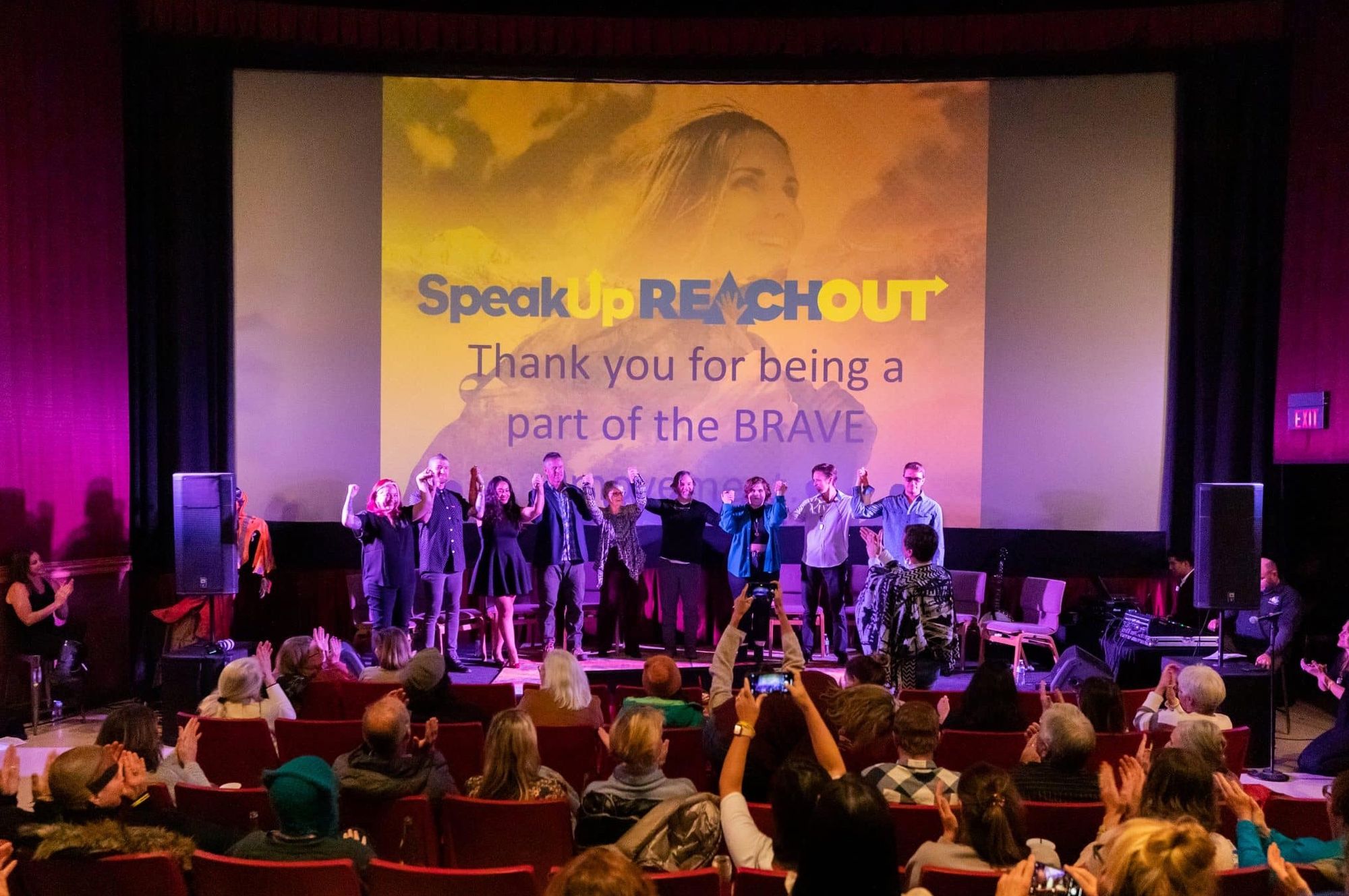By Caroline Paletta, Vail Daily
Seven people with the lived experience of mental illness, suicidality and addiction use various mediums to share their experiences in Edwards
SpeakUp ReachOut held a storytelling event on Oct. 27 at the Riverwalk Theater called "This Is My Brave." Seven community members shared their stories of resilience and recovery on stage.
This Is My Brave is a national nonprofit organization that uses storytelling and performance arts to reduce stigma and open conversation on mental health and addiction recovery. The show in Eagle Valley was the organization’s 85th production.
Erin Ivie, the executive director of SpeakUp ReachOut, said that she has been working to host a local This Is My Brave show for years because sharing personal stories contains a lifesaving power. “I am a firm believer that storytelling saves lives, and that somebody in the audience today had to hear these stories to save their life,” Evie said.
Seven community members — five from Eagle County, one from Summit County and one from Garfield County — took center stage to share their story in a format of their choosing, bringing their experiences to life for the audience through poetry, film, storytelling, multimedia performance art and music. Each auditioned for the show earlier in the summer and workshopped their delivery through four rehearsal sessions before taking the stage for a live show Thursday night.
Ivie encourages those who are inspired to share their stories to make sure that they are ready, and said that anyone can reach out for support in the storytelling process by contacting SpeakUp ReachOut or accessing storytelling training online at UniteSurvivors.org.
“It’s really important that people are in the right place, and it’s good to have a conversation with maybe your therapist or your family and support network to really understand where you are in your journey and if you are ready to share your story,” Ivie said.
Stories change and save lives
Dani Rodriguez was the first to share her story. She began by kneeling on the ground with a red blindfold over eyes, fighting an internal monologue of negative self talk that she said is always present.
“You shouldn’t be on stage. You still have time to go away. You’re not worth it. You are so ugly. You should be dead. You don’t deserve it…. STOP,” she shouted, overcoming the words and removing her blindfold to face the audience.
Rodriguez is a recovering alcoholic and suicide attempt survivor. Born in Chile, she has lived in Eagle County since 2009, and she shared how she has learned to coexist with and ignore the destructive thoughts that have previously led her to substance abuse, panic attacks and suicidality. Even in the hours leading up to Thursday’s show, Rodriguez said that her mind was telling her not to show up, but where once she was blind to the distortion of her thoughts, she now knew how to face and disarm them.
“I just tell them not today,” Rodriguez said. “Today I have passion, I have determination. Estóy viva. Tengo fuego dentro de mí.”

Rodriguez said she was especially motivated to participate in This Is My Brave as the only Hispanic cast member. She wants to find ways to share her story of recovery with and provide support to the Hispanic community in Eagle County, particularly women who are struggling with their own mental health battles.
“That’s why I also tried to incorporate a few Spanish words, because it’s hard for Hispanics to actually talk about mental health,” Rodriguez said. “And then seeing it on the other side, more like the Anglo side, and being part of it with them and actually realizing that we feel the same — it just keeps opening my mindset. At the end, we are all going through the same stuff.”
Alex Mintling followed with a multimedia story that invited the audience to relive his logging accident in the summer of 2019. Photos of the day were accompanied by audio of emergency responders and, on stage, a chainsaw and Mintling’s clothing from the accident.
With this backdrop, Mintling shared how he had been trapped under an off-road vehicle for 45 minutes before being evacuated via helicopter to a trauma center in Denver. Although his physical wounds healed quickly, his mental wounds were untreated. He developed post-traumatic stress that led to pervasive suicidal thoughts.
Mintling said that he started reaching out for help by calling the Colorado Crisis Line, a constant, reliable source of support for him. “If they’re busy, leave a message. They will call you back,” Mintling said. “There was one day that was so bad for me that I called four times. Every time I called they welcomed me. They were glad to hear from me. I knew most of them on a first-name basis. I’d say ‘This is Alex from Eagle.’ At times, I felt like they were the only friends I had.”
Seeing how connection helped him overcome his struggles with PTSD, Mintling started a podcast called “The Builder’s Journey” in 2019 where, among a variety of topics, he shares stories that reduce mental health stigma surrounding and promote suicide prevention.

Talking about suicidality can bring people together to heal
Next, Sherry Hall lost her son, Gary, to suicide in 2020. Gary had lived with bipolar challenges since adolescence leading him to take his life.
Hall chose to read poems that she had written at different points in her son’s life. “My poems reflect some of his struggles and my reaction to them because to survive trauma one must be able to tell a story about it,” Hall said.
One poem was from the time Gary was 15, just starting to become a man, and experiencing the difficult transition away from childhood. Another poem followed from when he was 17, delving into self-destructive behaviors.
“Confused and angry, rejecting of hugs, my handsome young son sifts through his feelings with booze and drugs. To get him through these tough times, my love just isn’t enough.... My heart is torn up and so sad. Whenever his will is so strong, I know I have to stop asking myself where did I go wrong,” Hall read.
Her reading closed with a poem she wrote just after her son’s death in February 2020, when she had to plead for a box of her son’s belongings, each with a close personal memory attached to it. She ultimately received the box and keeps the objects close to her in his memory. On stage, she wore a necklace with a round pendant containing her son’s ashes, close to her heart, right over a Snoopy T-shirt that he loved to wear.
Sean Boggs screened his short film, “Dear Dad,” a project he directed and produced to advocate for suicide prevention. The film follows two letters, one from a son to his father and one from a father to his son, illustrating that communication and connection can turn loneliness into mutual understanding and support, one of the strongest antidotes to suicidal ideation.
Boggs said he felt called to make the film after his daughter’s friend died of suicide. He said that the project grew as more people became involved. Eventually, 34 people from around the world contributed to the film, each one, Boggs said, with their own point of connection to suicidality.
“I was talking to my friends and colleagues that also make films and TV shows, and something really changed there,” Boggs said. “Something that I thought was a minority, something that I thought maybe me and just a few people were going through, turned out to be something that everyone was going through.”
“That stigma is gone, that part is over for all of us,” Boggs said. “You’re not going to scare anyone away by saying you’re struggling.”
Mykaela “Myki” Jones, a 23-year-old writer from Carbondale, performed a poem of her own, in which she shared how the mistreatment and abuse she experienced during her relationships led to post-traumatic stress and enduring trauma about her relationship to her own body.
“A boy in my class got grabby and crass and I didn’t feel free as time went past,” Jones said. “When I finally told someone, doesn’t matter who it was, I was told to just ignore that and walk through life with love. How do you walk with love when every mirror you pass you hate what you see? How the hell was I supposed to love other people when I didn’t even love me?”
Jones is now a freelance reporter and poet who is working on her first novel, “I Ain’t Settling,” a fictionalized retelling of her traumas written to help empower survivors. In the deep and defiant emotion of her This Is My Brave poem, Jones condemned the lack of support when she reached out for help. She became committed to using her voice, her story and her rage to transform an environment of suffering into one of support, like she once sought.
“It took me long enough to see that no matter the beatings, there is one thing you can’t beat out of me,” Jones said. “Despite all odds, I’ll pass [support] along to this next generation of kids. I will be who I needed when I was their age. No matter the twists, I will help them harbor that rage, help them turn it into something that will change the world into someplace more inhabitable....”

Sarah Alder, an Army veteran from Summit County who works at the Department of Veteran Affairs and served as president of the only LGBTQ Veteran Service Organization in Colorado, shared the story of helping a fellow veteran experiencing severe PTSD. When she spoke with the veteran, named Tiffany, she hadn't met her before, but as she entered the apartment, knew immediately how to help.
“Tiffany was not seeking anything except emotional connection and presence,” Alder said. “She required pure, radical acceptance for how shitty she was feeling — not to be convinced to stay in this world because it would make someone else feel sad or hurt by losing her. She needed someone to just sit and be with her, right next to her in all of her shittiness, shame, self-loathing and suffering.”
Recovered from her post-traumatic stress episode, Tiffany came up with a concept for the Paper Fashion Show to create a dress made out of red and black dog tags: red for service members and veterans that live with post-traumatic stress and black for those who “experienced excruciating suffering which facilitated them taking their own lives.” Tiffany asked Alder to be the runway model for her completed project.
“Five months later after that night, I was literally being super-glued into a green woven paper corset, slipping on my own black army combat boots and proudly, yet somberly, walking down the runway wearing hundreds of paper dog tags representing the stories of veterans and service members a moment away from, or just after, the worst moment of their lives,” Alder said. “Tiffany was not being represented by the black dog tags.” The dress she made is on display at the Rocky Mountain Regional VA Medical Center in Aurora.
The final story was from Chris Davis, a Vail resident who suffered with severe obsessive compulsive disorder throughout his childhood and adolescence. As he grew older he began experiencing depression, which he would combat with substance misuse for over a decade. “It was obviously not a very good mix,” Davis said. “It helped for a while but very quickly started becoming my own worst enemy.”
He shared that he first experienced suicidal ideation when he was 15. He began struggling with his sexuality, and the thoughts increased after receiving multiple concussions in quick succession at the age of 18.
Davis said that he is still on a journey to work through the difficult parts of his life, but he brought to the stage one item that has been a constant source of light and joy – his banjo.

Strapping the instrument around his shoulder, he played an original song that rang through the theater and brought the night to a close.


